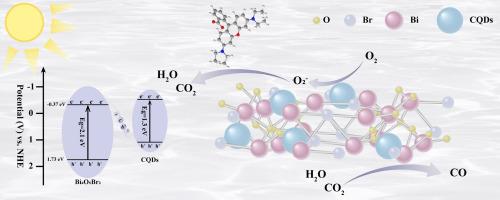缺陷CQDs修饰Bi4O5Br2构建S-scheme异质结构,用于高效光催化CO2还原和污染物降解
IF 9
1区 工程技术
Q1 ENGINEERING, CHEMICAL
引用次数: 0
摘要
设计能够光还原CO2和降解有机染料的高效光催化剂具有重要的现实意义。然而,障碍仍然存在,包括CO2吸附方面的挑战,载体分离效率低,光催化过程中的性能不理想。这项工作提出了一种直接的水热方法,将煤衍生的碳量子点(CQDs)结合到Bi4O5Br2纳米片上。CQDs与Bi4O5Br2的协同作用增强了CQDs/Bi4O5Br2异质结构的可见光吸收性能,提高了光生电子空穴的迁移效率。空位缺陷的设计对促进材料的光吸收、电荷分离和传输起着至关重要的作用。CQDs中碳空位的引入不仅产生了表面活性位点,而且显著提高了CQDs/Bi4O5Br2异质结构的电荷输运能力。由于S-scheme异质结构和空位工程的协同作用,最优样品BOB-2在3 h内获得了最高的CO产率307.73 μL g−1,无需任何牺牲剂,并且在15 min内对Rhodamine B (RhB)的降解效率高达99.1 %,明显优于Bi4O5Br2。深入分析了CO2还原和RhB降解的反应机理。本研究为煤基碳材料的利用提供了新的视角,并为高效光催化剂的设计提供了一条途径。本文章由计算机程序翻译,如有差异,请以英文原文为准。

Defective CQDs modified Bi4O5Br2 to construct S-scheme heterostructure for efficient photocatalytic CO2 reduction and pollutant degradation
Designing highly efficient photocatalysts capable of photoreducing CO2 and degrading organic dyes is of practical importance. Nevertheless, obstacles remain, including the challenges in CO2 adsorption, low efficiency of carrier separation, and unsatisfactory performance in photocatalytic processes. This work presents a straightforward hydrothermal method for incorporating coal-derived carbon quantum dots (CQDs) onto Bi4O5Br2 nanosheets. The synergy between CQDs and Bi4O5Br2 enhances the visible light absorption properties of the CQDs/Bi4O5Br2 heterostructure and improves the migration efficiency of photogenerated electron holes. The design of vacancy defects plays a crucial role in promoting light absorption, charge separation, and transport of materials. The introduction of carbon vacancies in the CQDs not only creates surface active sites but also significantly enhances the charge transport capability of the CQDs/Bi4O5Br2 heterostructure. Due to the synergistic effects of the S-scheme heterostructure and vacancy engineering, the optimal sample BOB-2 achieved the highest CO yield of 307.73 μL g−1 in 3 h without any sacrificial agent, along with a Rhodamine B (RhB) degradation efficiency of up to 99.1 % within 15 min, markedly surpassing the performance of Bi4O5Br2. The reaction mechanism of CO2 reduction and RhB degradation was thoroughly analyzed. This study provides a novel perspective on the utilization of coal-based carbon materials and outlines a pathway for the design of efficient photocatalysts.
求助全文
通过发布文献求助,成功后即可免费获取论文全文。
去求助
来源期刊

Separation and Purification Technology
工程技术-工程:化工
CiteScore
14.00
自引率
12.80%
发文量
2347
审稿时长
43 days
期刊介绍:
Separation and Purification Technology is a premier journal committed to sharing innovative methods for separation and purification in chemical and environmental engineering, encompassing both homogeneous solutions and heterogeneous mixtures. Our scope includes the separation and/or purification of liquids, vapors, and gases, as well as carbon capture and separation techniques. However, it's important to note that methods solely intended for analytical purposes are not within the scope of the journal. Additionally, disciplines such as soil science, polymer science, and metallurgy fall outside the purview of Separation and Purification Technology. Join us in advancing the field of separation and purification methods for sustainable solutions in chemical and environmental engineering.
 求助内容:
求助内容: 应助结果提醒方式:
应助结果提醒方式:


